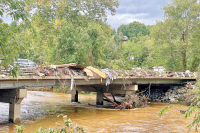New tax values, fire protection costs drive rate discussion

With the 2021 property revaluation now complete, Jackson County’s taxable value will rise nearly 20 percent over the value established during the last valuation in 2016 and 12.1 percent over the value for the current fiscal year, the last using 2016 valuations.
While the tax department is still managing some appeals to those new values, the properties involved account for less than 4 percent total parcels. The upshot is a value increase of more than $1 billion. Without factoring in the outcome of appeals still in progress, the newly assessed value of $10.97 billion would bring in $41.7 million in taxes based on the current rate of 38 cents per $100 of value — a significant hike from the $37.2 million for 2020-21.
Now it’s budget season, and Jackson County commissioners are considering what tax rate to set for the year ahead.
An increase in valuation means an increase in taxes for homeowners if the rate remains the same. For example, a person who owned a home valued at $200,000 in the 2016 revaluation would have paid $760 in county taxes in 2020. If that home’s value rose at countywide average rate of 19.9 percent, it would be worth $239,800 in 2021 and the tax bill at 38 cents per $100 would be $911.24.
During a March 11 work session, Finance Director Darlene Fox recommended that commissioners consider lowering the tax rate to 34.47 cents per $100 in the upcoming budget. This number would allow for a revenue-neutral levy plus an additional 1.7 percent to account for average cost increases. Under this proposed tax rate, that same homeowner with a $239,800 house would pay $826.59 in county taxes.
Related Items
Fire tax hike requested in Cashiers
The effective tax rate could ultimately end up higher, at least for some Jackson County residents. During that same March 11 work session, commissioners heard from Cashiers-Glenville Volunteer Fire Department Chief Randy Dillard and Cullowhee Volunteer Fire Department Chief Tim Green, both of whom said their departments need more money, and that the funding should come from fire taxes.
Cashiers residents have been paying a fire tax since 2015, when they to place a tax of 2.33 cents per $100 of property value to help the department address aging equipment, growing response times and increasing difficulty attracting volunteers. While the department has held steady for the past six years, a burgeoning influx of visitors and new residents have kept Dillard’s department more than busy. Last year alone, firefighters responded to 712 fire calls and 42 structure fires.
Dillard is asking that the fire tax increased to 2.94 cents per $100. The money will pay for additional firefighters and go toward newly acquired debt payments to fund a fire truck and land for a new station.
“I understand any tax increase is a tax increase, but the numbers are in our favor,” he said.
While the rate hike would represent a 26.18 percent increase over the 2020-21 rate, it is expected to bring in 48.3 percent more than the $1.21 million collected last year, a total of $1.79 million. That’s due to a larger tax base and a higher collection rate, said Fox.
Commissioners responded favorably to the request.
“It’s a changing time in Jackson County as far as the influx of people and population and homes,” said Commissioner Gayle Woody. “It’s probably going to continue, so you’re being proactive and that’s good.”

Cullowhee Fire Department seeks new funding
Green’s request for Cullowhee, which does not currently have a fire tax, elicited more discussion.
The department is in dire need of funding to hire paid firefighters, said Green. It currently receives an average of 2.5 calls per day, but response time is long — about 10 minutes. That might not seem like much, but 10 minutes is enough for a fire to go from a constrained blaze surrounding a knocked-over candle to a full-blown inferno capable of completely destroying an entire home.
There’s a simple reason for the lag in response, said Green. The department has only one paid member — everybody else is a volunteer.
“People have to come from home or work to get to possible life or death situations,” he said.
To add to the issue, the department has struggled to recruit newer, younger volunteer members. About a third of the volunteers have been there for more than 20 years, with many approaching 40 and several getting ready to turn 50. Firefighting is a physically demanding job, and young bodies do it better.
“Used to be you’d go up to the firehouse on a Monday night and there would be 30, 40 guys sitting there and they’d all be excited about being there,” said Commission Chairman Brian McMahan, who is also a longtime volunteer at the Balsam-Willets-Ochre Hill Volunteer Fire Department. “You’d have a call, you’d have a big turnout. But today I have literally been on a call where I’ve been the only person on the truck — me, myself and I — because nobody else comes.”
But funding a paid fire staff in Cullowhee will be more difficult to pull off than doing so in Cashiers. In the Cashiers district, 1 cent per $100 to the tax rate pulls in $598,000 based on the new tax values. In Cullowhee, 1 cent per $100 generates $117,000. The Cashiers fire district includes 14,510 taxable parcels, while the Cullowhee fire district has less than half that, with 6,139 taxable parcels.
Funding the $1.2 million in operating expenses Green is requesting would require adding 10.35 cents per $100 to Cullowhee residents’ taxes, or 12.05 cents per $100 to also accommodate $200,000 in annual debt payments on the new fire station. Commissioners were careful to say that the fire tax is not being discussed in order to fund the new station, as that cost was planned for separately. Rather, the fire tax is under discussion as a means to fund salaries for paid positions.
A complex issue
During a follow-up discussion March 16, commissioners agreed that Cullowhee needs the money but also that adding such a large amount to the tax rate is not realistic.
“That’s a huge increase for those people in that community,” said McMahan. “At the same time I want to try to find a way to help them. Personally, I’m not in favor of the fire tax district. I think there are other options.”
Commissioner Tom Stribling, whose district includes Cullowhee, agreed with McMahan, and Woody also said she would not support such a large tax increase for Cullowhee.
Part of Cullowhee’s issue is the fact that its fire department serves tax-exempt Western Carolina University. Because the 600-acre campus is state property, it does not pay county taxes. The state does contribute about $100,000 each year for fire protection, and the WCU Foundation threw in an additional $18,000. That’s not enough, said Green.
“One avenue to try to increase that is to argue to increase the value of that property,” said County Manager Don Adams. “The other argument — and this is probably a better path to take — is to try to get the state to put more money in the pot for fire protection.”
In the meantime, commissioners agreed, they need to find a way to meet Cullowhee’s needs now. McMahan suggested reaching out the county’s five other rural departments to see what their needs are and potentially considering a new, countywide fire tax district. The new district could encompass the entire county, or it could retain Cashiers as a split-off district. This approach could better distribute the costs and allow the departments to meet their needs without a massive tax increase, McMahan said.
Currently, the county allocates $1.56 million from the general fund and divides it between the six fire departments that do not have a tax district.
While each fire department serves a specific geographical area, in reality the departments are interconnected through a web of mutual aid agreements. So, while a Sylva resident might be miffed at helping to pay for firefighters in Cullowhee, the reality is that if that resident’s house catches on fire, Cullowhee firefighters will respond alongside those from Sylva.
“That’s the only way these (N.C. Department of Insurance) requirements are being met, to have multiple departments responding simultaneously to the same call,” said McMahan. “In some ways we want to support all the departments, because all of the departments have to support each other.”
Following the discussion March 16, County Manager Don Adams said he would work with staff to reach out to the various fire departments and to come up with options to fund the requests. At a minimum, he said, the county has to start working on ways to fund Cullowhee’s needs.
The issue will be discussed further at the next work session on Tuesday, April 13, or potentially during a special-called meeting in early April. Adams is scheduled to present the recommended budget for 2021-22 during the regular meeting on Tuesday, May 18.













